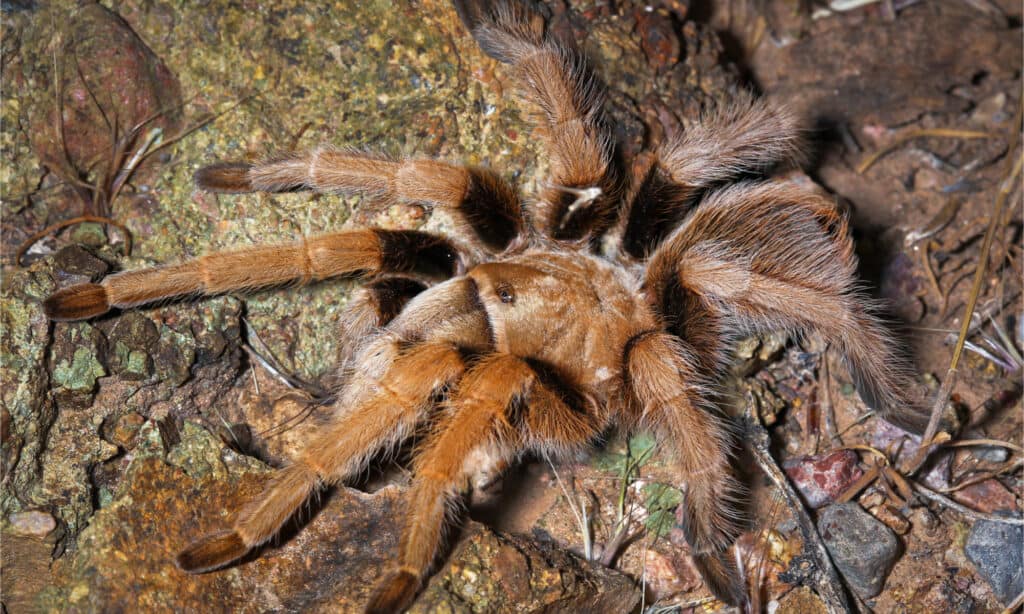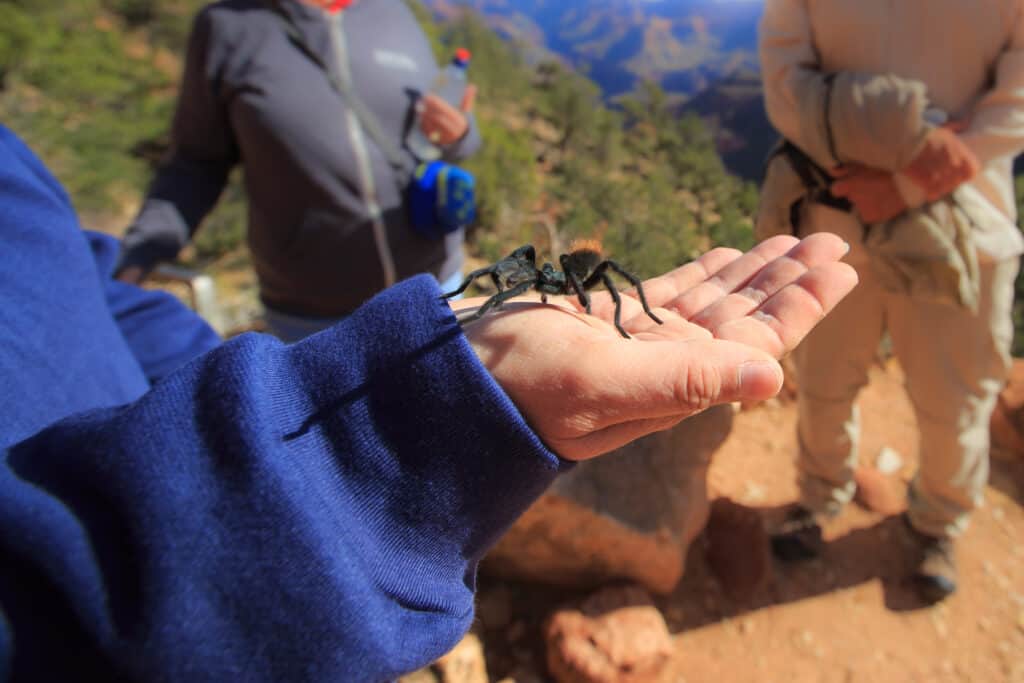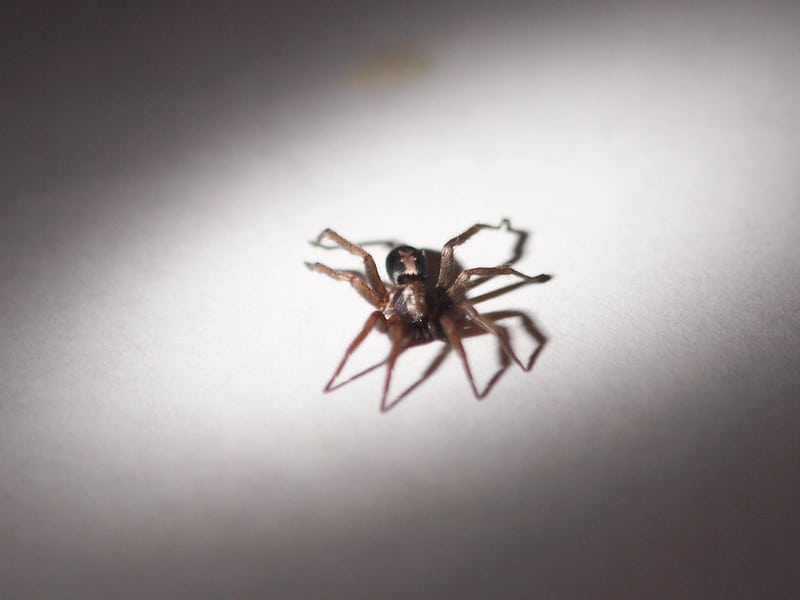Arizona is located in America’s southwestern region and has one of the warmest desert climates. Due to this, it is home to over 27 species of spiders. With different spider species in Arizona, you are bound to find some uniquely giant spiders, so before you panic or flee, read this article to figure out the five most enormous spiders in Arizona, their length, and if they indeed are harmful. Let’s dive in!
1. The Arizona Blond Tarantula

Ryan M. Bolton/Shutterstock.com
The Arizona Blond Tarantula, also known as the Western Desert Tarantula or the Mexican Blond Tarantula, is found in the Sonoran desert in Arizona and Mexico. They are the most common Tarantula in Arizona and belong to the family Theraphosidae.
This unique insect got “blond” in its name from the color of its carapace, which can be considered its head. The carapace is covered with pale hair, while the other part of this animal is distinctively black. Furthermore, in their appearance, the Arizona Blond Tarantula is 3- 5 inches long with a large body.
This animal’s female species is usually more prominent with a uniform tan color. These animals have very low toxicity, and can be kept as pets because of their dorsal nature. Also, they have a very long life expectancy of around 30 years, so you don’t have to worry about your pets dying on you anytime soon-that is if you decide to keep them as pets. These Arizona animals create a burrow 1-2 inches long and spend most of their time there.
2. The Grand Canyon Black Tarantula

Losonsky/Shutterstock.com
The Grand Canyon Black Tarantula would be considered the second most giant spider on this list. You might begin to wonder why the first and second animals on this list are Tarantulae – probably because the Tarantula is a naturally giant spider, and there are over 30 species in Arizona.
These Tarantula species have a more distinct appearance; they are black all through, from their heads down to all their legs. Like the Arizona Blond Tarantula, the adult Grand Canyon Tarantula can get up to 3-4 inches long. They also have a very docile nature and live in their burrows most of the year, just like their sibling tarantulas we spoke about above. These spiders are also known as the Goliath bird-eating spiders. But ironically, they do not eat birds; birds, in fact, prey on them sometimes.
3. The Giant Crab Spider

Andrey Zharkikh / Creative Commons 2.0 – License
Also known as the Golden Huntsman Spider, this spider gets its name from its physical appearance; they are large and have an average length of 2 to 2½ inches. Some other species of this spider, mainly located in Laos, can attain a leg span of 9.8- 11.8 in.
They are from the family Sparassidae, characterized by their eight eyes. If you’re not paying attention, you might mistake the Giant crab spider for its tarantula counterparts. However, their distinctive feature is their forward twisted crab-like legs. The huntsman spider has various shades of brown and gray, but their undersides are most times marked with black. They are also mostly found under rocks, barks and similar shelter, rarely spotted in homes. They mostly stay in places seldom frequented by humans.
Unlike the above two, these spiders are known to be venomous and have caused severe injury with their defensive bites on humans. The effects of their strikes on humans might include; sore pain at the bite, vomiting, heart palpitations, etc. Moreover, the results of the bite might be more prominent if it didn’t occur once, but bites from a Giant crab spider can’t lead to death.
4. The Carolina Wolf Spider

Will E. Davis/Shutterstock.com
The Carolina Wolf Spiders are a large species found in Arizona and some other states in northern America. The fully grown adult of this species measures between 18mm – 35mm, with the males being smaller than the females. They also appear to be brown with a dark underpart. The male of this species stands out with orange coloration on its side.
These spiders have a unique two-way venom that not only paralyzes their prey but also restricts microbes from the prey infecting them. Moreover, they hunt from their self-made burrow or the ones they find. There is a distinct way to identify the male species of the Carolina Wolf Spiders – by the orange coloration. Still, the female species can only be identified during their breeding season as they carry their egg sacs on their body during incubation. Additionally, their eyes shine and reflect light in the night; which is a great way to identify them in the dark.
5. The Western Parson Spider

The Western Parson spiders are unique spider species characterized by their body structure and abdominal markings similar to an old-style cravat. Their bites are considered painful and can cause an allergic reaction. Also, these insects are medium-sized, measuring about 10-20mm long, and are very fast. They are covered with black hairs on their head and gray hairs on their abdomen. Their back has a distinctive white color and is right above their spinnerets.
They can be found in the wild, under rocks or logs, in the forest, and they can also wander into your home. They hibernate during the day and go out to hunt insects at night. They are ambush predators, and they run up to their prey and bite them instantly.
Up Next:
Discover The Largest Spider In Arizona
Meet The Absolute Largest Spider in History
The post 5 of the Biggest Spiders in Arizona appeared first on AZ Animals.
from Animal News, Facts, Rankings, and More! - AZ Animals https://ift.tt/1AhWb5w